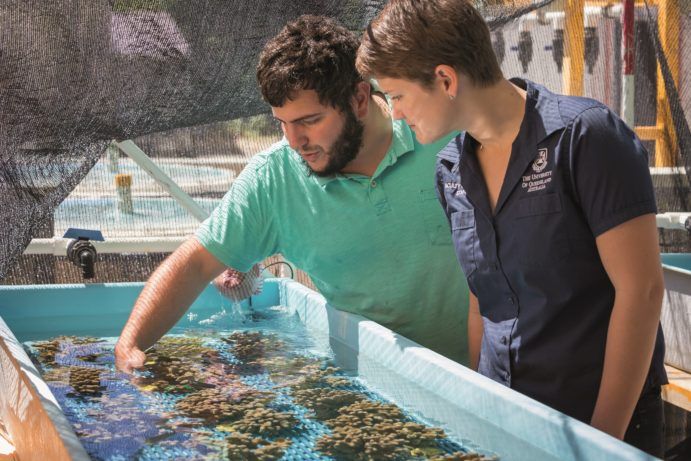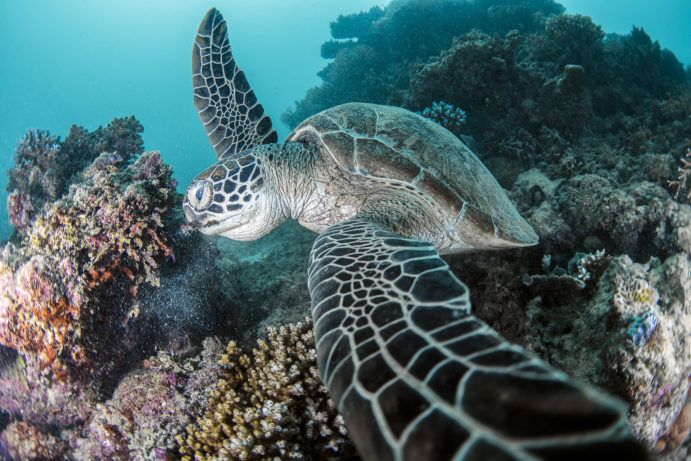10 incredible facts about the Great Barrier Reef
LIST
By Jess Pridmore
The Great Barrier Reef: it’s one of the most iconic, most beautiful and most diverse locations on earth. Stretching from Cape York in northern most Queensland down to Bundaberg on the central coast, this enormous living organism (the world’s largest) is nothing short of breathtaking. And it’s right on our doorstep. Get to know more about this Australian icon with these 10 incredible Great Barrier Reef facts. They’ll have you planning all the details of your next trip faster than you can say ‘tropical paradise’.
1. It’s the only place on earth where two UNESCO World Heritage Sites meet

Officially a UNESCO World Heritage site since 1981, just one accolade was not enough for this jaw-droppingly beautiful part of the world; so it got two. The Reef hugs the coastline of the incomparable Wet Tropics, the oldest rainforest in the world. Both are home to some of the rarest creatures and prehistoric plant life on earth, giving it near-on magical status. Pretty spectacular stuff.
2. It’s bigger than Tasmania and Victoria, combined
Stretching 2,300 kilometres along two-thirds of the Queensland coast, the Great Barrier Reef is enormous. It’s the only living structure in the world that can be seen from space and covers an area bigger than two Australian states. Big doesn’t begin to cover it.
3. You’ll find a third of the world’s coral here

More than 400 coral species can be found in the Great Barrier Reef Marine Park, making it not only an impressive feat of Mother Nature but an important, and highly protected, habitat to thousands of marine species found nowhere else on earth.
4. And it’s home to nearly 5,000 marine and mammal species
Thanks to its abundant coral reefs and protected coral cays (we’re talking 600+ pristine beaches and remote tropical islands), the Great Barrier Reef is home to some of the world’s most unique creatures. More than 1,500 species of fish, 215 bird species, 3,000 species of molluscs, six of the world’s seven species of marine turtle, 30 species of whale and dolphin, and one of the world’s most important dugong populations all call this stretch of ocean home.
5. You can volunteer on the Great Barrier Reef

Visiting the Great Barrier Reef is a life-changing experience in itself, but helping ensure its survival for generations to come will stay with you forever. Destinations such as Heron Island, Lady Elliot Island and Lady Musgrave Island are award-winning for their eco-sustainable accommodation and on-site research and volunteer programs.
Ensuring facilities and guests leave no footprint, you can be beachside one day, rehabilitating a baby turtle or learning about coral health the next.
6. The reef ‘tax’ helps fund much-needed research
To ensure the ongoing protection of the Great Barrier Reef, an environmental management charge (EMC) of AUD$7 per day is paid by anyone who visits the Great Barrier Reef Marine Park for three hours or more. Less than three hour visits will incur a fee of AUD$3.50. While the entire region hugely benefits from tourism, these much-needed funds go toward the ongoing research and protection conducted by marine park officers.
7. You’ll find some of the most famous dive sites in the world here

North Horn
While the average depth of the Great Barrier Reef hovers around 35 metres, the Continental Shelf drops to depths of more than 2,000 metres, making it a hotbed of marine life activity.
Offering some of the most impressive diving locations in the world, depending on the time of year you could be swimming with whales on Norman Reef, watching a shark feeding frenzy at North Horn or be drifting next to manta rays off Lady Elliot Island. Being spoilt for choice on the Reef is just a way of life.
8. October to November is coral spawning season
Each year the Great Barrier Reef puts on the world’s largest, most impressive coral spawning event. While it usually occurs around the full moon in November, in 2022 it's taking place 12-14 October. Releasing eggs and sperm into the ocean at exactly the same time, cloud-like plumes rise to the surface to fertilise. This synchronised reproduction happens over a period of just a few days and is key in helping the reef grow and repair. Oh, and it’s wildly beautiful to witness. If you time your visit right…
9. Swim with Australia’s Great 8

Snorkelling is one of the best ways to encounter the Great Eight; just remember to keep your eyes peeled. While the Southern Great Barrier Reef is manta ray territory, you’ll see Humpback whales migrating the length of the Queensland coast during the winter months.
Turtles stretch the length of the Great Barrier Reef; you’ll likely spot at least one on a snorkelling trip. But, if you want to witness hatchlings taking their first tiny steps toward their life in the ocean, head straight to Mon Repos in Bundaberg. If swimming with the world’s most iconic sea creatures is on your bucket list, then you’ve come to the right reef.
10. View the Great Barrier Reef from above
In 2012 Google launched the very first underwater ‘Street View’ on the Great Barrier Reef. The Underwater Earth project uses data and imagery from the ground-breaking Catlin Seaview Survey project – a series of expeditions aiming to explore and survey the health of coral reefs worldwide – so you can spy on the antics of the Reef’s inhabitants.
